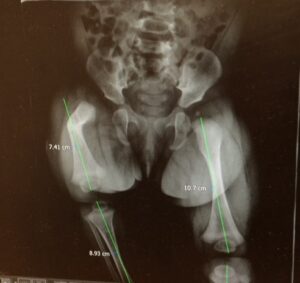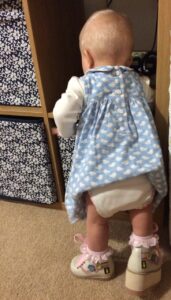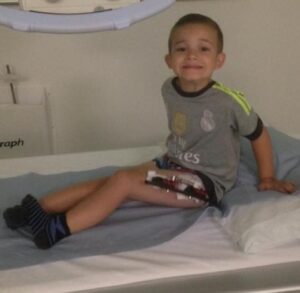PFFD – Proximal Femoral Focal Deficiency
PFFD stands for Proximal Focal Femoral Deficiency. It sounds very complicated but when you look at each word individually it is actually a very good description of the condition.
- Proximal – nearest the point of attachment or centre of the body
- Femoral – the thigh bone or femur
- Focal – a focus or starting point
- Deficiency – shorter or less than the normal amount
In other words, the end of the thigh bone closest to the hip is too short or not completely developed. In most cases, the hip joint is also not well developed.
 The typical appearance is an unusually short thigh bone that is pulled upwards and turned toward the outside. The foot of the affected leg is often at the level of the opposite knee.The knee often has varying degrees of instability as well. How well the foot works generally depends on the severity of any associated leg deficiency, such as Fibular Hemimelia. The condition may be one leg (unilateral) or both legs (bilateral).
The typical appearance is an unusually short thigh bone that is pulled upwards and turned toward the outside. The foot of the affected leg is often at the level of the opposite knee.The knee often has varying degrees of instability as well. How well the foot works generally depends on the severity of any associated leg deficiency, such as Fibular Hemimelia. The condition may be one leg (unilateral) or both legs (bilateral).
Diagnosis and causes
The thigh bone is measured as part of pregnancy scans. Diagnosis at this stage will depend on the amount of shortening of the bone. In milder cases diagnosis will only be made at birth or later as the legs start to grow and the difference in length between the two legs becomes more noticeable.Steps have produced a downloadable publication, Leg Length Difference for parents who have been told of a possible problem with their baby’s legs.
 The causes of PFFD are unknown, but it is known that it does not run in families (not genetic). It is likely that a shoe raise (pictured right) will be used as the child grows and learns to walk prior to any surgical intervention. This will be dependant on the severity of the condition and any other problems associated with the hip or knee.
The causes of PFFD are unknown, but it is known that it does not run in families (not genetic). It is likely that a shoe raise (pictured right) will be used as the child grows and learns to walk prior to any surgical intervention. This will be dependant on the severity of the condition and any other problems associated with the hip or knee.
How can it be treated?
 PFFD may sometimes be treated using limb lengthening techniques but often results in a deficiency that is too great, or a knee and hip that are too unstable, for limb lengthening to be successful. Steps have also produced a guide to help parents and carers prepare themselves and their child for a hospital admission.
PFFD may sometimes be treated using limb lengthening techniques but often results in a deficiency that is too great, or a knee and hip that are too unstable, for limb lengthening to be successful. Steps have also produced a guide to help parents and carers prepare themselves and their child for a hospital admission.
The image to the left shows an Ortho fix device for lengthening the femur.
Watch our video on leg lengthening
The hip will often need to be stabilised by surgery. If hip surgery is required, it may be possible that a hip spica cast is used and the Steps guide Hip Surgery and Spica Cast Care may be useful. The Steps You Tube channel also has short film clips about caring for an older child in a hip spica; Caring for a Child in a Hip Spica – The Older Child.
Where the only solution is a prosthetic extension to the leg:
- The knee can be fused in place and the foot removed to produce a stable stump so that an above-knee prosthesis can be fitted.
- Another procedure (van-nes-rotationplasty), where the knee is fused but the leg is turned to face backwards and the ankle joint is used as a knee can be used. The foot then fits into the prosthesis.
Steps have produced a Parent’s Guide to Planned Amputation to help parents and carers prepare themselves and their child for a lower limb amputation and another publication – Preparing For Your Child’s Surgery to help parents and carers prepare themselves and their child for a hospital admission.
Steps have produced a downloadable publication about PFFD to introduce parents to the condition and discuss possible treatments which can be downloaded amongst other information in the Resources below.
Jude’s Personal Story:
Watch our video on planned amputation in lower limb conditions
